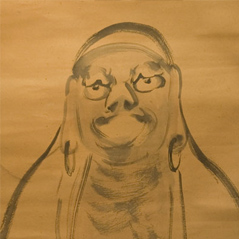Fujiyama Dojo P.O. Box 20003 Thorold, ON, Canada L2V 5B3 (905) 680-6389 |
|---|
 Sumi-e, literally "black-ink picture", was brought from China to Japan by Zen priests, about five centuries ago. It is another way to express one's spirit with the freedom of humility, letting the art flow without desire or ambition, for as long as your motivation is the wish to excel, any skill that is tried will "become as nothing."
It is not about calculated graphic minimalism, abstractionism, or pretentiousness. Approaching it as an art meant to honor the artist would be depriving it of truth and feeling. When the artist remains a quiet vehicle and it is the art which is allowed to be, then, through modesty, the image flows, growing from no merit of the artist, but with all virtue in the image.
The Zen priests rejected the use of color, emphasizing that underneath all the worldly confusions, complications and chaos, the truth was often simple, and so were the ultimate solutions of all conflict around us. Such simplicity is sumi-e.
"Sumi-e is to art", said Ogawa Usen, "what compassion is to the world. A simple virtue that expresses and conveys all others. A simple view that shows more than a deep scrutiny."
Ink painting remains a relatively popular art form in the Orient. In Japan, themes such as bamboo, chrysanthemums, birds, and cherry blossoms are still as popular as they have ever been.
To the martial artist, the spirit of sumi-e resembles the spirit of true Budo, where an art is practiced for the art's sake, and the drive for performance produces only a negative influence in the spirit, eventually killing the art itself in the individual.
True art, and true self-expression, occurs only when the art is revered, and the artist remains humble.
As Kushara, sumi-e teacher, said, "The brush speaks the loudest when the one holding it is like a whisper." Sumi-e, literally "black-ink picture", was brought from China to Japan by Zen priests, about five centuries ago. It is another way to express one's spirit with the freedom of humility, letting the art flow without desire or ambition, for as long as your motivation is the wish to excel, any skill that is tried will "become as nothing."
It is not about calculated graphic minimalism, abstractionism, or pretentiousness. Approaching it as an art meant to honor the artist would be depriving it of truth and feeling. When the artist remains a quiet vehicle and it is the art which is allowed to be, then, through modesty, the image flows, growing from no merit of the artist, but with all virtue in the image.
The Zen priests rejected the use of color, emphasizing that underneath all the worldly confusions, complications and chaos, the truth was often simple, and so were the ultimate solutions of all conflict around us. Such simplicity is sumi-e.
"Sumi-e is to art", said Ogawa Usen, "what compassion is to the world. A simple virtue that expresses and conveys all others. A simple view that shows more than a deep scrutiny."
Ink painting remains a relatively popular art form in the Orient. In Japan, themes such as bamboo, chrysanthemums, birds, and cherry blossoms are still as popular as they have ever been.
To the martial artist, the spirit of sumi-e resembles the spirit of true Budo, where an art is practiced for the art's sake, and the drive for performance produces only a negative influence in the spirit, eventually killing the art itself in the individual.
True art, and true self-expression, occurs only when the art is revered, and the artist remains humble.
As Kushara, sumi-e teacher, said, "The brush speaks the loudest when the one holding it is like a whisper."
|
|---|


